Fishing Report: July 9, 2021
MADEIRA BEACH, Fla. - Every Friday morning, Captain Dylan Hubbard of Hubbard's Marina joins Good Day to fill viewers in on his fishing forecast as we head into the weekend.
Here is his fishing report for July 9, 2021.
Inshore
Snook action has really been great this past week despite the weather.
Really, the weather only had them more fired up. During our storm watch, many of our crew and captains that were manning the boats saw actively feeding snook to the point they were taking just about any baits we put down -- from live bait to dead cut baits.
The snook are biting best, it seems, at night around the bridge lights and dock lights, in and around the passes. However, during the day, you can find them around the passes, beaches, flats, oyster bars, and mangrove shorelines. Virtually anywhere you can find the bait or structure that may hold bait with decent water flow, the snook will be stacked up and ready to eat.
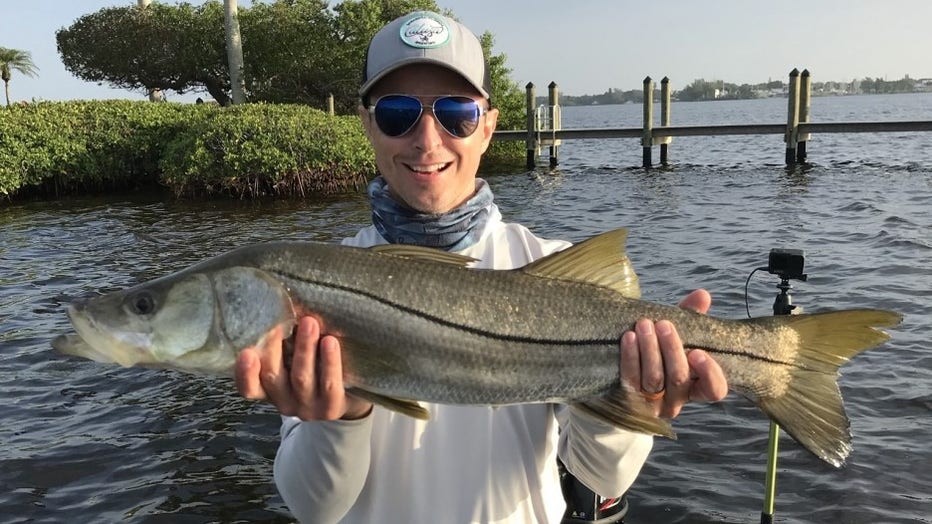
Snook caught inshore (Credit: Capt. Dylan Hubbard)
Redfish have been a bit pickier this past week, but we are seeing some nice ones on the bottom, around the passes, during the night, and daytime periods around the structures. Also, during the day, we are seeing them cruising the flats around those potholes and cuts. During high tides in the daytime periods, look for them cruising the mangrove shorelines or following the schools of mullet that are foraging the flats.
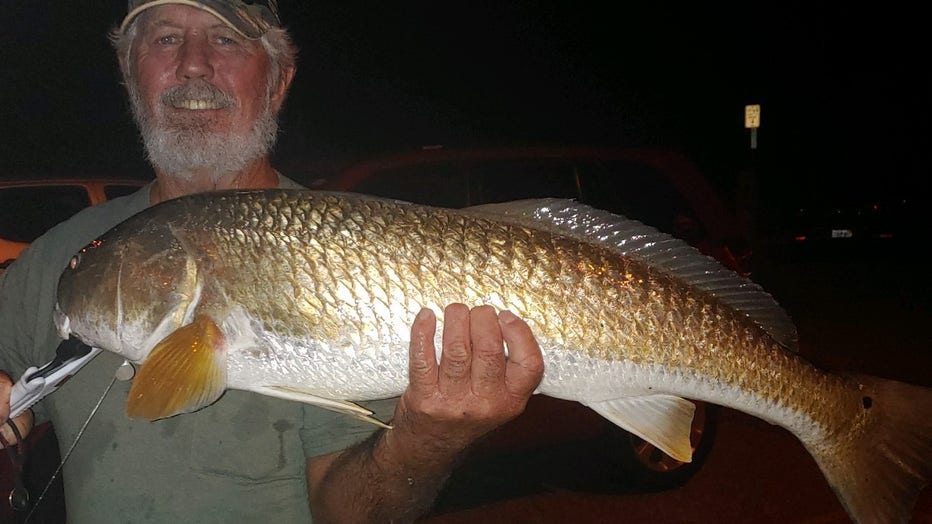
Redfish caught inshore (Credit: Capt. Dylan Hubbard)
Trout action has been steady, and we are finding them mostly on those deeper water flats or the edges of the shallower flats as shallow as 3-4 feet of water. They love finding those cooler water spots along the edges, or in the potholes or cuts.

Trout caught inshore (Credit: Capt. Dylan Hubbard)
Little swash channels that run along the flats are good areas to target trout too. We are seeing plenty of trout at night around bridge lights, dock lights, and other well-lit areas that are near the passes where water is flowing -- and bait is plentiful. Also, a few trout are being caught in the earlier morning periods around the jetties and beach fishing piers.
Black drum are still around biting well through the summer. They love hanging on the bottom near bridges, piers, and large dock structures. You can occasionally find schools along the beaches and flats as well. They love the cut bait on the bottom or live shrimp. Mostly, they target crustaceans like crabs, and the smellier the bait the better.
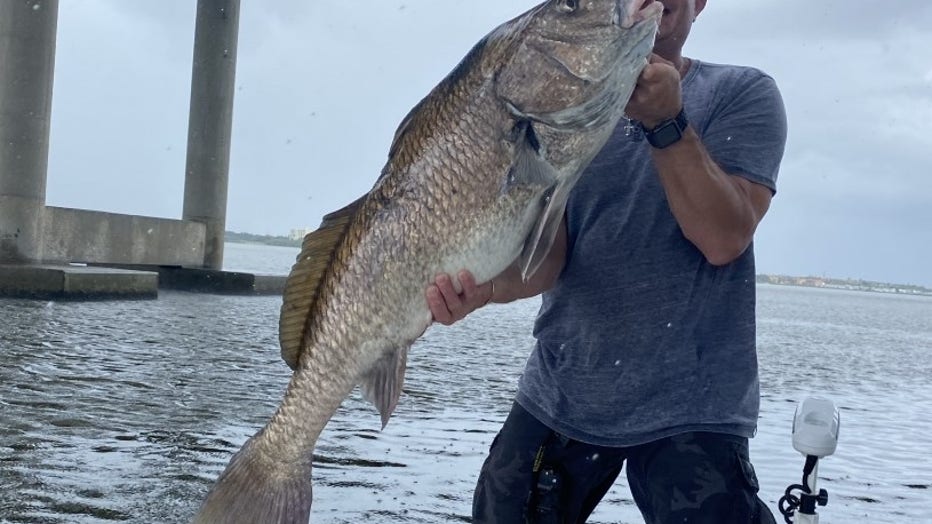
Mangrove snapper are still prolific around the back bay and pass waters of our inshore areas. They love to feed on smaller pieces of cut shrimp, clams, oysters, whitebait, and just about any small piece of meat that can be presented naturally adjacent to the structures they cruise like docks, piers, bridges, and jetties.
There’s still some sheepshead action too around the area, especially behind this storm. The influx of freshwater from all the rain will once again push some sheepshead into the bay area out of their creeks and upper bay summertime haunts.
Also, behind the storm, there should be plenty of floating debris around the bay for those tripletail to hide under. Keep an eye out when cruising between flats or bridges and you may get lucky to spot a triple tail hiding under a palm frond or something similar floating at the surface. Live shrimp on a popping cork or even free-lined works well for an option to target these unique-looking but exceptionally good-eating fish.
Near shore and offshore
We have had some turbulent weather this past week with Elsa moving through our coastal waters. However, prior to the storm, we got some good fishing done. The fish were picky, but cooperative.
It was definitely a bit more of a grind than expected prior to a big low pressure moving into the area pre-storm, but the fish did not disappoint. If you were able to grind it out and keep your bait at the bottom ready to fight.
The gag grouper bite has continued to impress out deep beyond 120-140 feet of water up to around 250 feet of water. We are seeing most of our big gags on large live baits or large dead baits. Whole octopus, squid, large bonita strips, big squirrelfish, and white grunts are examples of some of the baits that have helped us to land these big gag grouper lately with large 10-14ot hooks and 80-125lb test leaders.
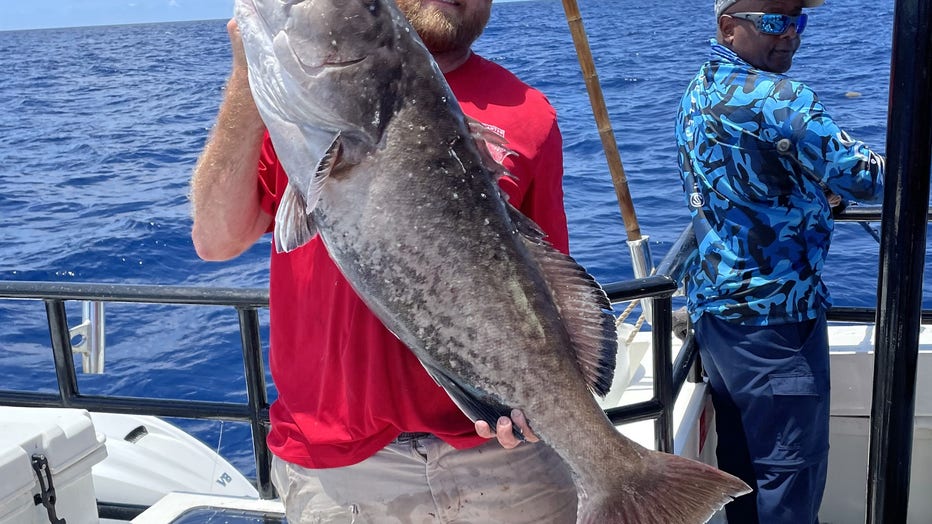
Gag grouper caught offshore (Credit: Capt. Dylan Hubbard)
The red snapper fishing has been steady for us too but has taken more time lately to get a full limit-pushing us deeper to do so as well. Right around 160-200 feet of water is our targeted depth right now for plentiful large red snapper.
They are loving dead baits around this depth like cut bonita strip, whole squid, or the double threadfin approach. 60-80lb test with around 7ot circle hooks is a great option for these hungry red snapper.
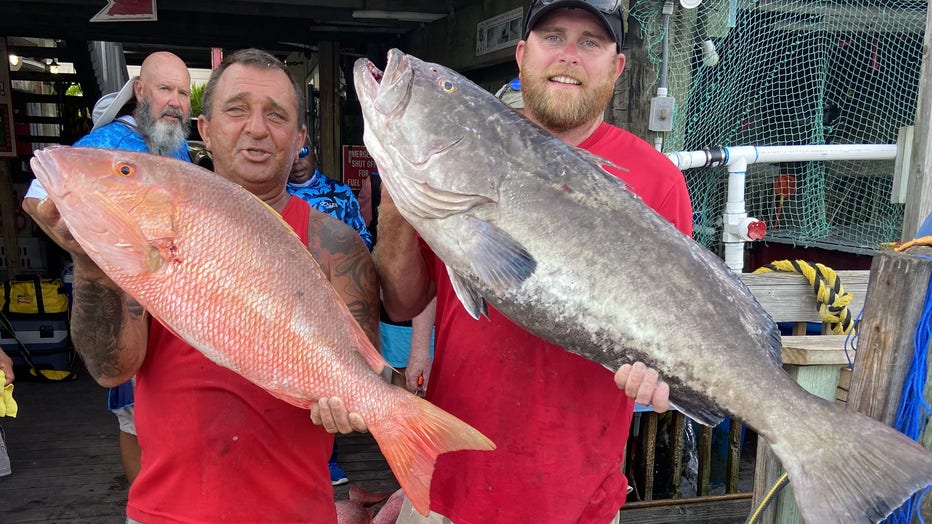
Red snapper and gag grouper (Credit: Capt. Dylan Hubbard)
We are seeing some large scamp grouper in the mix out deep as well. Many are being caught on the smaller to average-sized pinfish with around 60-80lb test and 6-7ot circle hooks. However, the vertical jigs do work well for the scamp grouper, and we have seen quite a few caught by those targeting mangrove snapper using 60lb test and 6ot double snell rigs and the threadfin chunks.
Mangrove snapper action is decent right now, but pickier than we would like it to be. However, this is due in part to targeting deeper waters overall for these red snapper and big gags. Mangrove action is best around 100-160 feet of water and was often beyond that range but still able to pick a few nice mangroves. The double snell right with chunked threadfin or sardine continues to be the ticket but smaller live pinfish work well for big mangroves as well.
Lane snapper are biting well near shore around 60 feet of water up to around the deepest near shore waters (around 100f tee). We are seeing them on live shrimp, cut squid or the threadfin chunks with lighter 30-40lb leaders and 4-5ot hooks.
Red grouper action is steady near shore too around the same depth as the lane snapper using squid strips or live pinfish. However, the big boy red grouper we have been seeing are mixed in with the red snapper on those deep-water potholes or bait shows going after big chunks of bonita, whole squid, longer squid strips or butterflied baits too.
Pelagic action was going well for us prior to the storm with some tuna, kingfish and a nice mahi mahi caught over this past weekend. There were still reports of the wahoo around out there too. Most of our pelagic interaction is incidental while bottom fishing. Even the big mahi mahi we saw was caught while dropping a cut threadfin down for mangrove snapper.
DON’T BE A FOOL, bring a venting tool & Descending device
Keep in mind the importance of dead discards and discard mortality when engaged in near shore or offshore fishing. How many do you know right now that are all for catching and releasing snook, redfish and trout but will be the first in line to kill a mangrove snapper, gag grouper, or red snapper? But the attitude completely changes when discussing these offshore species?
Plus, the same person inshore that will hold their breath and wet their hands before handling a breeder snook will go offshore and then cull through 20 red snapper before keeping their two red snapper they deem large enough to fill their two-fish bag limits. Meanwhile, the other 18 they released will often end up suffering fatal damage if not properly descended or vented?
Please help us to spread the word on the importance of descending or venting your released fish. Descending devices are most easy to use and quick to pick up on their use. They are most effective for most anglers.
However, an expert and precise angler with proper training and tons of experience can use a venting tool properly with similar outcomes. A venting tool requires you to pierce the fish while most descending devices are much less invasive. While using a venting tool, it is imperative you pierce them in the exact right spot, and you do not go but a quarter-inch or less in the fish. Most venting tools require you to ‘choke up’ on the tool to prevent over-penetration into major organs.
When fishing deep water, especially in the hot summer months, please make sure to treat all fish intended to be released like that breeder snook inshore and minimize the time it takes you to get him from the bottom to the boat using heavier proper tackle, not an ultra-light spinning reel.
Then once onboard, minimize the time out of the water. Then use a proper de-hooking tool and then, for the love of God, use a descending device or venting tool PROPERLY to ensure that fish has a chance to live another day.
Three things will help ensure the survivability of those fish released offshore:
- Making sure they are brought up quickly and do not expend all their energy in the fight.
- Make sure they are unhooked smoothly, easily, and as quickly as possible.
- Finally, make sure they spend the least amount of time at the surface at negative pressures where barotrauma exponentially increases its effect with each passing second.
Also, keep in mind when the water is warm, there is less dissolved oxygen content and the chances of barotrauma increase even more while its effects can be even more deadly.
LINK: Here’s all the information and more on barotrauma and how to mitigate that fatal damage to your future offshore catch
**Note: I recommend the Salt Strong articles at the bottom of the page under ‘webpages.’ I helped them develop those personally.
STATE SURVEY to improve recreational data and access
It is imperative that you have your Gulf Reef Fish survey endorsement on your fishing license.
You should get one if you are a private recreational angler or diver fishing from a private boat anywhere in Florida who intends to harvest, attempt to harvest or possess one or more of the following reef fish species: mutton snapper, yellowtail snapper, hogfish, red snapper, vermilion snapper, gag grouper, red grouper, black grouper, greater amberjack, lesser amberjack, banded rudderfish, almaco jack, gray triggerfish, Gag grouper, Red grouper, Scamp grouper, Mangrove snapper, Lane snapper, Kingfish, Tuna, or Mahi mahi.
Here is all the information and more on that program and how you can sign up.
TERMS OF REFERENCE:
INSHORE – from the back bays out to the bridges and including right on the beaches
NEAR SHORE – From the beaches out to 20 miles, or up to 100ft of water
OFFSHORE – from 20 miles or 100ft and beyond

